Jan Aronson | |
|---|---|
 Aronson in 2013 | |
| Born | Jan Aronson 1949 (age 74–75) New Orleans, Louisiana, U.S. |
| Occupation | Artist |
| Spouse | |
Jan Aronson (born 1949) is a New Orleans-born artist working and living in New York City.
Jan Aronson | |
|---|---|
 Aronson in 2013 | |
| Born | Jan Aronson 1949 (age 74–75) New Orleans, Louisiana, U.S. |
| Occupation | Artist |
| Spouse | |
Jan Aronson (born 1949) is a New Orleans-born artist working and living in New York City.
Aronson was born to a Jewish family [1] in New Orleans. [2] In her early years Aronson worked as an instructor of art for the New Orleans Museum of Art, Dillard University, Southern Vermont Arts Center, Ethan Allen Community College, Johnson State College and Pratt Manhattan Center. Aronson has been a full-time artist since 1986.
Her work is in the public, private and corporate collections of New Orleans Museum of Art - Permanent Collection, Eiteljorg Museum of American Indians and Western Art - Permanent Collection, United Nations Watch of the World Jewish Congress, Geneva, Switzerland, United States Mission, Geneva, Switzerland, Residence of the Israeli Ambassador to the United States, Washington, DC, Ronald Lauder Collection, New York, NY, Fairfield University, Fairfield, CT, Glenn Janss Collection of American Realist Paintings, Vermont Council on the Arts, Michael Steinhardt Collection, Jerry Speyer Collection, Karen and William Lauder Collection, Isidore Newman School, Altamer Resort, Anguilla, British West Indies, Delaware Beverage Company Art Collection, to list a few. [3] [4]
Aronson became known for her landscapes. [5] Garrit Henry wrote for the publication Art in America: "Jan Aronson has confessed that Abstract Expressionism is a major influence on her landscapes. With some looking, it’s easy to see that she is something of an expressionist herself. She has traveled endlessly in search of the sublime – she has hiked in the Himalayas and barged down the Amazon, and she knows well the American Northeast and West. How the human self perceives, pictures and, above all, enlarges upon the drama of nature is what Aronson’s work is about." And Mark Daniel Cohen wrote for the publication Art News: "Everything Aronson depicts has a quality of motion that is like the gesturing of a human body."
Aronson is noted for her portrait work as well. Having painted the likes of Arthur Hertzberg, Mariel Hemingway, Norman H. Nie and Edgar Miles Bronfman. The latter businessman and philanthropist was married to Aronson from 1994 till his death in 2013.
After the attack on the World Trade Center Aronson headed to ground zero. During her visit she noticed a piece of rust on one of the remaining steel columns. This inspired her Leaves Series, seeing leaves as an homage to the tragedy. Miranda McClintic wrote: "Aronson started the series with straightforward depictions of leaves, isolated from their natural context on complementary colored grounds. As time went on she increasingly monumentalized and abstracted their forms, layering different kinds of leaves, with contrasting colors, shapes and textures. The close-up camera views on which the paintings and watercolors of leaves are based allow for microscopic examination of multiple surface variations and tones, while their large scale, rich colors, and dense layering of paint transforms them into dramatic emblems.
As the series continued through 2004, Aronson focused increasingly on formal concerns and the evocation of vitality. In the paintings and watercolors of sea-grape leaves that she collected in Anguilla, the colors radiate tropical beauty, the compositions stress the complex patterns of leaf stems and veins, and the leaves are subjectified by filling the entire pictorial space."
Following the Leaves series Aronson began exploring the forms of rocks and water, which led to a series she calls While Rome Burns.
Aronson is a member of the National Association of Women Artists, Artists Equity and a Board Member of The Skowhegan School.
Awards include:

Helen Frankenthaler was an American abstract expressionist painter. She was a major contributor to the history of postwar American painting. Having exhibited her work for over six decades, she spanned several generations of abstract painters while continuing to produce vital and ever-changing new work. Frankenthaler began exhibiting her large-scale abstract expressionist paintings in contemporary museums and galleries in the early 1950s. She was included in the 1964 Post-Painterly Abstraction exhibition curated by Clement Greenberg that introduced a newer generation of abstract painting that came to be known as color field. Born in Manhattan, she was influenced by Greenberg, Hans Hofmann, and Jackson Pollock's paintings. Her work has been the subject of several retrospective exhibitions, including a 1989 retrospective at the Museum of Modern Art in New York City, and been exhibited worldwide since the 1950s. In 2001, she was awarded the National Medal of Arts.
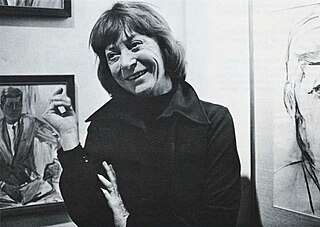
Elaine Marie Catherine de Kooning was an Abstract Expressionist and Figurative Expressionist painter in the post-World War II era. She wrote extensively on the art of the period and was an editorial associate for Art News magazine.
Kinuko Yamabe Craft is a Japanese-born American painter, illustrator and fantasy artist.
Jan D'Esopo is a painter and sculptor, mainly active in Puerto Rico.
Chantal Joffe is an American-born English artist based in London. Her often large-scale paintings generally depict women and children. In 2006, she received the prestigious Charles Wollaston Award from the Royal Academy.

Elizabeth Nourse was a realist-style genre, portrait, and landscape painter born in Mt. Healthy, Ohio, in the Cincinnati area. She also worked in decorative painting and sculpture. Described by her contemporaries as "the first woman painter of America" and "the dean of American woman painters in France and one of the most eminent contemporary artists of her sex," Nourse was the first American woman to be voted into the Société Nationale des Beaux-Arts. She also had the honor of having one of her paintings purchased by the French government and included in the Luxembourg Museum's permanent collection. Nourse's style was described by Los Angeles critic Henry J. Seldis as a "forerunner of social realist painting." Some of Nourse's works are displayed at the Cincinnati Art Museum.
Judith Brown was an American dancer and a sculptor who was drawn to images of the body in motion and its effect on the cloth surrounding it. She welded crushed automobile scrap metal into energetic moving torsos, horses, and flying draperies. "One of the things that made Judy stand out as an artist was her ability to work in many different mediums. Some of this was by choice, and sometimes it was by necessity. Her surroundings often dictated what medium she could work with at any given time. After all, you can't bring you're welding gear with you to Rome."
Ogden Minton Pleissner (1905–1983) was an American painter, specializing in landscapes and war art related to his service in World War II.
Hollis Sigler was an American artist. She received several Arts Lifetime Achievement awards as both an artist and an educator, including the Distinguished Artist Award for Lifetime Achievement from the College Art Association in 2001.
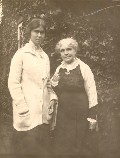
Hilda Belcher was an American artist known for her paintings, watercolors, portraits, and illustrations depicting individuals and landscapes, both in formal portraiture and in casual scenes of children and daily life. She was the second woman to be accepted into the National Academy of Design. In 1935, Anne Miller Downes, a reviewer for The New York Times, called Belcher was "one of the most distinguished women artists in America".

Jennie Augusta Brownscombe was an American painter, designer, etcher, commercial artist, and illustrator. Brownscombe studied art for years in the United States and in Paris. She was a founding member, student and teacher at the Art Students League of New York. She made genre paintings, including revolutionary and colonial American history, most notably The First Thanksgiving held at Pilgrim Hall in Plymouth, Massachusetts. She sold the reproduction rights to more than 100 paintings, and images of her work have appeared on prints, calendars and greeting cards. Her works are in many public collections and museums. In 1899 she was described by New York World as "one of America's best artists."
Willie Anne Wright is an American photographer best known for her colorful cibachrome and grayscale Pinhole Photography.
Elizabeth Osborne is an American painter who lives and works in Philadelphia. Working primarily in oil paint and watercolor, her paintings are known to bridge ideas about formalist concerns, particularly luminosity with her explorations of nature, atmosphere and vistas. Beginning with figurative paintings in the 1960s and '70s, she moved on to bold, color drenched, landscapes and eventually abstractions that explore color spectrums. Her experimental assemblage paintings that incorporated objects began an inquiry into psychological content that she continued in a series of self-portraits and a long-running series of solitary female nudes and portraits. Osborne's later abstract paintings present a culmination of ideas—distilling her study of luminosity, the landscape, and light.
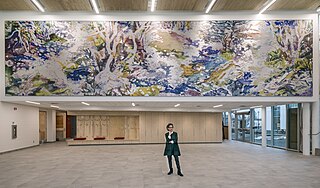
Susan G. Scott is a Canadian artist known for both contemporary figurative painting and, more recently, her landscapes. Her work is found in national and international public collections including the Canada Council for the Arts, Musée national des beaux-arts du Québec, Musée d'art contemporain de Montréal, Art Gallery of Nova Scotia, Collection du Fonds régional d'art contemporain d’Île-de-France in Paris, Canada - Israel Cultural Foundation in Jerusalem and Houston Baptist University in Texas. She was elected to the Royal Canadian Academy of Arts (RCA) in 2013.

Ghitta Caiserman-Roth was a Canadian painter and printmaker. She was a founder of the Montreal Artist School and her work is in the National Gallery of Canada. Caiserman-Roth was also an associate member of the Royal Canadian Academy and the first painter to receive the Governor General's Award for Visual Media and Art.

Bernadine Custer, also known as Bernadine Custer Sharp and Mrs. A.E. Sharp was a 20th-century American painter, illustrator and WPA muralist who worked in New York City and Vermont. Her artistic style has been described as "American Regionalism" and often features genre paintings and watercolors inspired by her neighbors and surroundings. Her work has been compared to other artists of her generation such as Thomas Hart Benton, Grant Wood, and Norman Rockwell.

Margaret Casey Gates (1903–1989) was an American artist, painter, art teacher and administrator. She participated in the New Deal's Section of Painting and Sculpture under the Treasury Department, creating the post office mural for Mebane, North Carolina, and a watercolor which was held at Fort Stanton in New Mexico. In addition, she has paintings held in several noted collections in the United States.
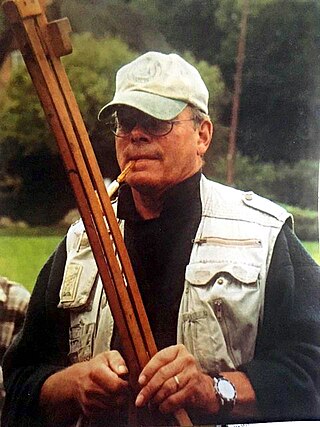
Charles Clark Reid was an American painter, illustrator, and teacher, notable for his watercolor style. He won numerous national and international awards for both his watercolor and oil works, and also hosted many workshops in the US and abroad. He published numerous books and instructional DVDs and created a postage stamp and an iconic ad campaign with his watercolor depictions. His watercolor works and oil paintings are in private and college museum collections.
Sylvia Safdie is a Canadian artist who gathers and utilizes found natural materials in a variety of mediums such as painting, sculpture, drawing, installation, photography and video to explore different themes in her work, calling upon early childhood memories, her Jewish heritage, and her experience of moving from Israel to Canada. She works and lives in Montreal, Québec.
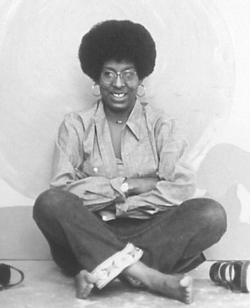
Ruth Tunstall Grant (1945–2017) was an African American artist, educator and activist in the San Francisco Bay Area known for her paintings, community activism, and arts advocacy. Her work has been featured in many invitational group exhibitions as well as solo shows at national and international venues such as Dallas Museum of Fine Art, Dallas, Texas; Rath Museum, Geneva, Switzerland; Triton Museum of Art, Santa Clara, California; San Jose Museum of Art, San Jose, California; and Los Gatos Museum of Art, Los Gatos, California. She had a strong focus on community service and advocacy of children’s rights and social justice in and beyond Santa Clara County. She established many innovative, ongoing arts programs and inspired creative activists, such as Marita Dingus.
Jan come from a nonobservant but nonetheless committed New Orleans Jewish family.